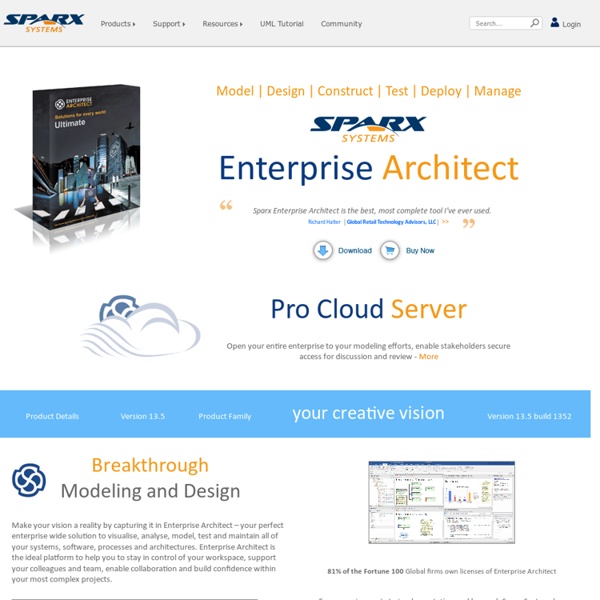UML tools for software development and modelling - Enterprise Architect UML modeling tool
Enterprise Architect 11 Version 11 is a significant milestone with hundreds of enhancements, new features, refinements and capabilities all designed to extend the modeling power, ease of use and standards compliance Enterprise Architect has championed over the last decade. We encourage you to take a look and discover for yourself how Enterprise Architect 11 will revitalize and empower your models, designs, software, systems and business processes. Read More... Unique in its ability to pull together complex domains and create a single, accessible, unified vision. Combines high end tools, a commitment to open standards, accessible pricing and online availability.
http://www.sparxsystems.com/
Examples of Gliffy UML Diagrams
Unified Modeling Language, or UML, is a standard language for visually representing the requirements, analysis, design, and implementation of a system. Bring it all together UML diagrams show structural (static), behavioral (dynamic) and implementation characteristics — and the shape and connector libraries in Gliffy make it easy. Since no single diagram can model a system completely, Gliffy's UML diagram editor makes it easy to add more diagrams as you need them. Just drag and drop from a library of shapes to show any of the nine UML diagrams needed to model a system: Use case diagram Class diagram Object diagram State diagram Activity diagram Sequence diagram Collaboration diagram Component diagram Deployment diagram
Altova
Rational Unified Modeling Language - UML Resource Center
The Unified Modeling Language™ UML is a visual language for specifying, constructing, and documenting the artifacts of software-intensive systems. Complex software designs difficult for you to describe with text alone can readily be conveyed through diagrams using UML. Modeling provides three key benefits:
Visual Paradigm for UML
Visual Paradigm for UML (VP-UML) is a UML CASE Tool supporting UML 2, SysML and Business Process Modeling Notation (BPMN) from the Object Management Group (OMG). In addition to modeling support, it provides report generation and code engineering capabilities including code generation. It can reverse engineer diagrams from code, and provide round-trip engineering for various programming languages. Product Editions[edit] Higher-priced editions provide more features.[3] The following editions were available in November 2010:
Visual Paradigm Company Overview
Visual Paradigm International continuously strives to empower organizations to develop quality applications — faster, better and cheaper. We help our customers to understand their organizations and translate requirements into quality software with our tools that are both richly featured and simple to use. As the saying goes, a picture is worth a thousand words. We do see visual modeling a great way to communicate efficiently, especially during project crunch times.
Unified Modeling Language
The Unified Modeling Language (UML) is a general-purpose modeling language in the field of software engineering, which is designed to provide a standard way to visualize the design of a system.[1] It was created and developed by Grady Booch, Ivar Jacobson and James Rumbaugh at Rational Software during 1994–95 with further development led by them through 1996.[1] In 1997 it was adopted as a standard by the Object Management Group (OMG), and has been managed by this organization ever since.
A UML Profile for Data Modeling
Unfortunately data modeling is not yet covered by the Unified Modeling Language (UML), even though persistence-related issues are clearly an important aspect of object-oriented software project. For several years I have argued that the UML needs a data model (first in Building Object Applications that Work in 1997 and most recently in Refactoring Databases) and have vacillated between various ways that it should be done. Other methodologists have argued the same (Naiburg and Maksimchuk 2001, Muller 1999) because they too recognize the clear need to extend the UML. Unfortunately we have all come up with slightly different modeling notations, a problem that the UML is supposed to address if my memory serves me correctly. The good news is that the Object Management Group (OMG) issued an RFP for an official UML Data Modeling Profile in December 2005.
Related:
Related:



